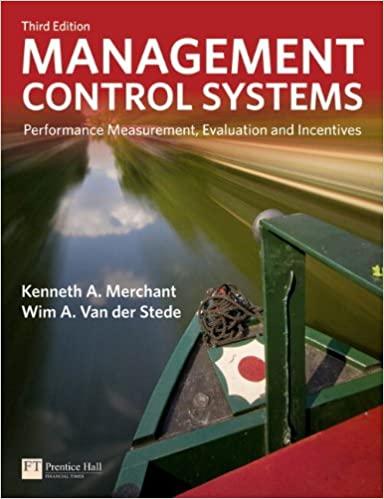Question
Problem 18-04 Allocation of Overhead Nature Cosmetics Company applies overhead costs on the basis of machine hours. The overhead rate is computed by analyzing data
Problem 18-04 Allocation of Overhead
Nature Cosmetics Company applies overhead costs on the basis of machine hours. The overhead rate is computed by analyzing data from the previous year to determine the percentage change in costs. Thus, this years overhead rate will be based on the percentage change multiplied by last years costs.
| Last Year | |
| Machine hours | 55,360 |
| Overhead costs: | |
| Indirect labor | $ 23,500 |
| Employee benefits | 28,600 |
| Manufacturing supervision | 18,500 |
| Utilities | 15,000 |
| Factory insurance | 7,800 |
| Janitorial services | 12,100 |
| Depreciation, factory and machinery | 21,300 |
| Miscellaneous overhead | 6,000 |
| Total overhead | $132,800 |
This year the cost of utilities is expected to increase by 40 percent over the previous year; the cost of indirect labor, employee benefits, and miscellaneous overhead is expected to increase by 30 percent over the previous year; the cost of insurance and depreciation is expected to increase by 20 percent over the previous year; and the cost of supervision and janitorial services is expected to increase by 10 percent over the previous year. Machine hours are expected to total 68,786.
1. Compute the projected costs, and use those costs to calculate the overhead rate for this year. (Round the rate to two decimal places.)
| Nature Cosmetics Company | |||||
| Overhead Rate Computation Schedule | |||||
| For This Year | |||||
| Overhead Cost Item | (1) Last Year | (2) Projected Percentage Increase | (3) Projection This Year ( 1 x 2) | ||
| Indirect labor | $23,500 | % | $ | ||
| Employee benefits | 28,600 | % | |||
| Manufacturing supervision | 18,500 | % | |||
| Utilities | 15,000 | % | |||
| Factory insurance | 7,800 | % | |||
| Janitorial services | 12,100 | % | |||
| Depreciation, factory and machinery | 21,300 | % | |||
| Miscellaneous overhead | 6,000 | % | |||
| Total overhead | $132,800 | $ | |||
Predetermined overhead rate for this year: $ per machine hour 2. Jobs completed during this year and the machine hours used were as follows. Determine the amount of overhead to be applied to each job and to total production during this year. Use the rounded value of the rate from the previous step in your calculations.
| Job No. | Machine Hours | Predetermined Overhead Rate | Overhead Applied | ||
| 2214 | 12,300 | $ | $ | ||
| 2215 | 14,200 | ||||
| 2216 | 9,800 | ||||
| 2217 | 13,600 | ||||
| 2218 | 11,300 | ||||
| 2219 | 8,100 | ||||
| Totals | 69,300 | $ | |||
3. Actual overhead costs for this year were $165,845. Was overhead underapplied or overapplied? -Select-UnderappliedOverappliedItem 32 overhead: $ Should the Cost of Goods Sold account be increased or decreased to reflect actual overhead costs? Cost of Goods Sold should be -Select-increaseddecreasedItem 34 . 4. At what point during this year was the overhead rate computed? When was it applied? Finally, when was underapplied or overapplied overhead determined and the Cost of Goods Sold account adjusted to reflect actual costs?
*********************************
Problem 18-3 Job Order Cost Flow On May 31, the inventory balances of Tog Designs, a manufacturer of high-quality children's clothing, were as follows: Materials Inventory, $21,360; Work in Process Inventory, $15,112; and Finished Goods Inventory, $17,120. Job order cost cards for jobs in process as of June 30 had these totals: Job no. Direct Materials Direct Labor Overhead 24-A $1,593 $1,290 $1,677 24-B 1,492 1,380 1,794 24-C 1,987 1,760 2,288 24-D 1,608 1,540 2,002 The predetermined overhead rate is 130 percent of direct labor costs. Materials purchased and received in June were as follows. June 4 $33,120 June 16 28,600 June 22 31,920 Direct labor costs for June were as follows. June 15 payroll $23,680 June 29 payroll 25,960 Direct materials requested by production during June were as follows. June 6 $37,240 June 23 38,960 On June 30, Tog Designs sold on account finished goods with a cost of $183,000 for $320,000. 1. and 3. Using T accounts for Materials Inventory, Work in Process Inventory, Finished Goods Inventory, Overhead, Accounts Receivable, Payroll Payable, Sales, and Cost of Goods Sold, reconstruct the transactions in June, including applying overhead to production. Determine the ending inventory balances. In case two transactions of the same date should be recorded using the same T account, enter direct labor before overhead. Post the amoumts in chronological order. Select the appropriate date for each posted amount. Materials Inventory End. Bal. Work in Process Inventory End. Bal. Finished Goods Inventory End. Bal. Overhead End. Bal. Accounts Receivable End. Bal. Payroll Payable End. Bal. Sales End. Bal. Cost of Goods Sold End. Bal. 2. Compute the cost of units completed during the month. $ 4. Jobs 24-A and 24-C were completed during the first week of July. No additional materials costs were incurred, but Job 24-A required $960 more of direct labor, and Job 24-C needed an additional $1,610 of direct labor. Job 24-A was composed of 1,800 pairs of trousers; Job 24-C, of 900 shirts. Compute the product unit cost for each job. Round your answers to the nearest cent. Product Unit Cost Job 24-A $ Job 24-C $
Step by Step Solution
There are 3 Steps involved in it
Step: 1

Get Instant Access to Expert-Tailored Solutions
See step-by-step solutions with expert insights and AI powered tools for academic success
Step: 2

Step: 3

Ace Your Homework with AI
Get the answers you need in no time with our AI-driven, step-by-step assistance
Get Started


